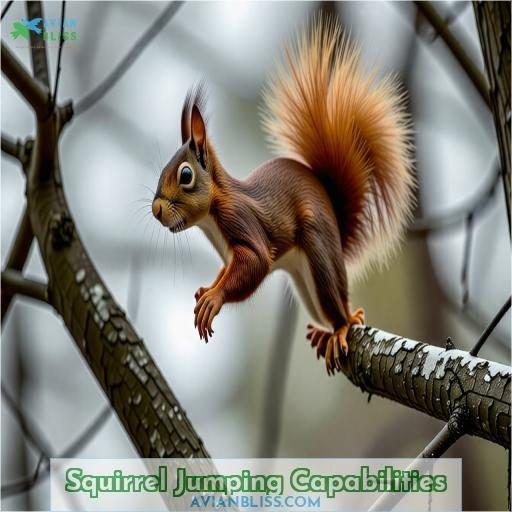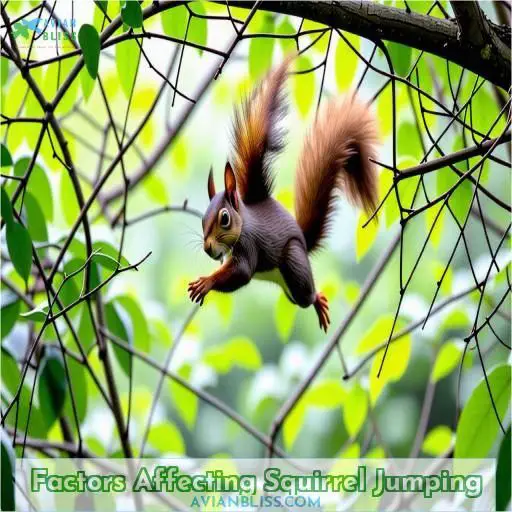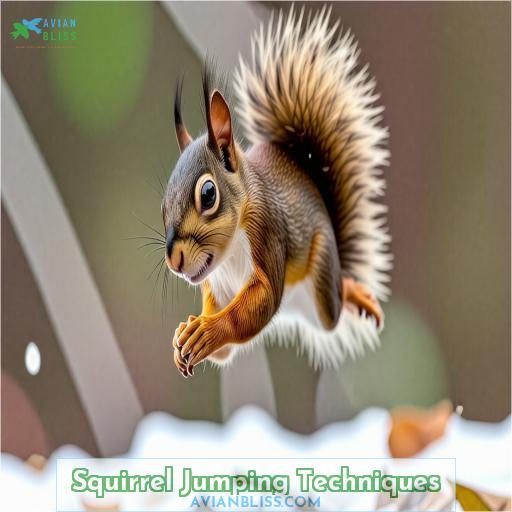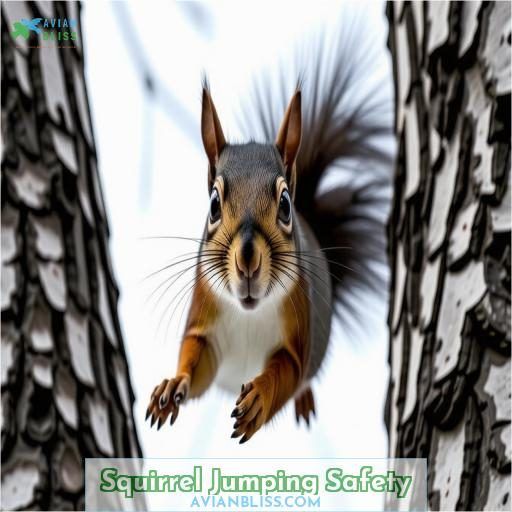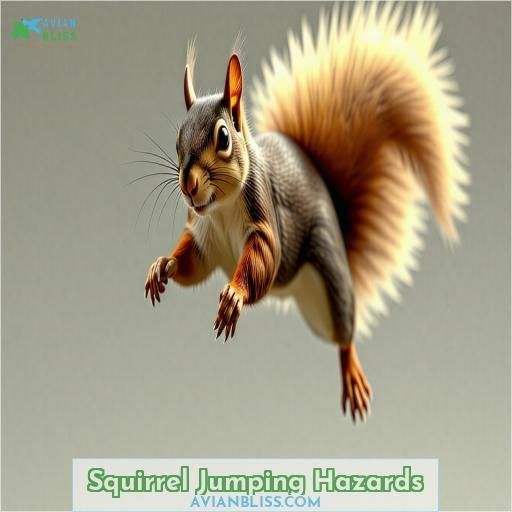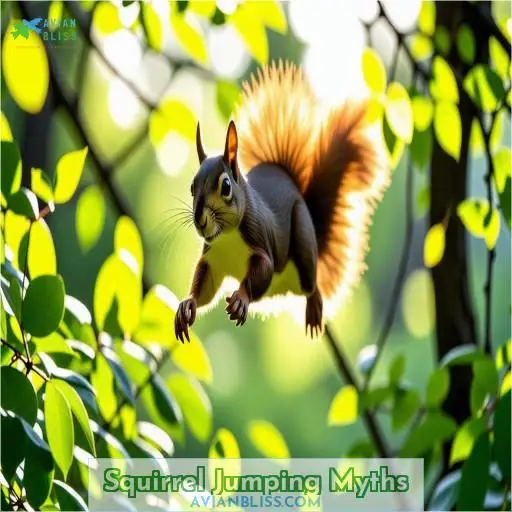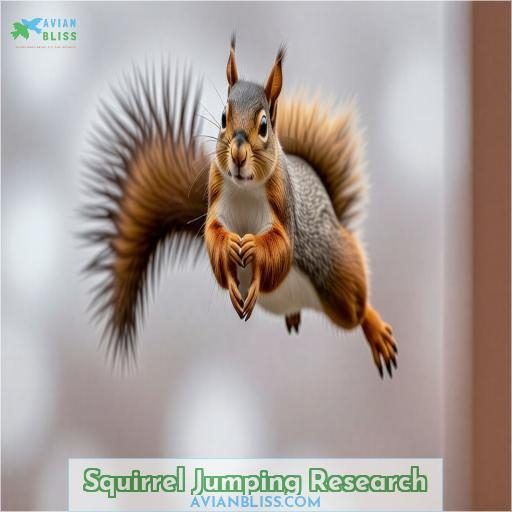This site is supported by our readers. We may earn a commission, at no cost to you, if you purchase through links.

These nimble creatures are true acrobats, capable of soaring up to 6 feet vertically and leaping across gaps of 10-12 feet horizontally with ease. Their powerful hindlegs, lightweight build, and agile movements allow them to navigate through treetops and obstacles effortlessly.
Factors like body size, muscle strength, age, and motivation influence their jumping prowess.
But these incredible jumping adaptations ultimately enable squirrels to thrive in their arboreal habitats.
Intrigued by their remarkable jumping abilities? Dive deeper to uncover the fascinating techniques and behaviors behind their gravity-defying leaps.
Table Of Contents
- Key Takeaways
- How Far Can a Squirrel Jump?
- Squirrel Jumping Capabilities
- Factors Affecting Squirrel Jumping
- Squirrel Jumping Techniques
- Squirrel Jumping Adaptations
- Squirrel Jumping Behavior
- Squirrel Jumping Records
- Squirrel Jumping Safety
- Squirrel Jumping Hazards
- Squirrel Jumping Myths
- Squirrel Jumping Research
- Frequently Asked Questions (FAQs)
- Can squirrels jump 20 feet?
- How far can squirrels jump from a tree to a bird feeder?
- How far can a squirrel jump from a tree to a roof?
- Can squirrels jump upwards?
- What is the average jumping distance for a squirrel?
- How high can a squirrel jump vertically?
- What factors influence a squirrels jumping ability?
- How do squirrels use jumping in their daily lives?
- Are there any records for the farthest squirrel jump?
- Conclusion
Key Takeaways
- Gray squirrels can jump vertically up to 6 feet and horizontally across gaps of 10-12 feet with ease, thanks to their powerful hind legs, lightweight build, and agile movements.
- Factors like body size, muscle strength, age, and motivation influence squirrels’ jumping prowess, with young, healthy squirrels exhibiting the greatest jumping abilities.
- Squirrels’ jumping techniques involve using their powerful hind legs for thrust, agile movements for changing direction mid-jump, and bushy tails as counterbalances and rudders for stability and steering.
- While squirrels’ jumping abilities allow them to thrive in their arboreal habitats, they can also pose potential hazards like jumping onto power lines or roads, causing electrical outages or collisions with vehicles.
How Far Can a Squirrel Jump?
Gray squirrels can jump up to 6 feet vertically and 10-12 feet horizontally, with the longest recorded jump being 15 feet horizontally. Their jumping ability is aided by powerful hindlegs, agile movements, and a bushy tail that provides stability and steering during jumps.
Squirrel Jumping Capabilities
Gray squirrels are renowned for their incredible jumping abilities, capable of leaping up to 6 feet vertically and clearing gaps of 10-12 feet horizontally. Their powerful hindlegs, lightweight build, and agile movements allow them to effortlessly navigate through the treetops and across obstacles with ease.
Gray Squirrels Can Jump Up to 6 Feet High Vertically
Gray squirrels are incredible vertical leapers, able to spring up to 6 feet high! This impressive ability allows them to quickly ascend trees and access food sources. Their powerful hindlegs and lightweight build provide the thrust needed for these vertical jumps, which are essential for escaping predators and traveling from tree to tree (Source).
They Can Jump Across Gaps of 10-12 Feet Horizontally
Gray squirrels are masters of horizontal leaping, able to bound across gaps of 10-12 feet with ease. Their powerful hindlegs, lightweight frame, and sharp claws allow them to vault between trees, a crucial skill for traversing dense forests.
While impressive, these jumping feats can also lead to hazards like falls or becoming trapped in unwanted areas. Squirrels’ incredible jumping adaptations enable them to flourish in their arboreal habitats.
Factors Affecting Squirrel Jumping
Squirrels’ jumping abilities are influenced by a variety of factors, including their body size, muscle strength, age, health status, and motivation. Understanding these factors can provide insight into how far and high squirrels can leap, and why their jumping prowess varies across individuals and situations.
Body Size and Weight
Your body size and weight play a big role in how far you can jump. Heavier squirrels with more muscle mass can leap higher and farther than lighter ones. Adult males are usually larger than females due to sexual dimorphism. Pregnant females may have trouble jumping as far during gestation. Distribute your weight evenly to maximize jumping distance.
Muscle Strength and Condition
Squirrels’ muscle strength and condition are key factors in their incredible jumping abilities. Engaging in regular endurance training and agility drills helps build the necessary muscle power and coordination for leaping long distances. Proper nutrition, including protein for muscle development, is also essential for optimizing jumping performance and preventing injuries.
- Engage in regular endurance training and agility drills
- Consume a balanced diet rich in protein for muscle development
- Maintain muscle strength and condition through consistent exercise
- Prevent injuries by gradually increasing training intensity and volume
Age and Health Status
As a squirrel ages, its jumping prowess may diminish. Young squirrels are agile and fearless, leaping with abandon. But older squirrels, while wiser, may hesitate more. Diseases like squirrel pox can weaken muscles and bones, limiting jumping ability. Mortality rates spike for elderly squirrels, so caution becomes paramount. Jumping is a young squirrel’s game.
| Age | Jumping Ability | Mortality Rate |
|---|---|---|
| Young | Excellent | Low |
| Middle-aged | Good | Average |
| Elderly | Declining | High |
Presence of Injuries or Illness
Injuries and illness can notably impact a squirrel’s jumping ability. Factors like:
- Injury severity
- Illness impact
- Age-related decline
- Health-adjusted jumping
Adaptive jumping techniques help squirrels compensate, but severe injuries or illnesses may limit their jumping range and agility. Tracking injured squirrels reveals altered movement patterns and communication with predators. Maintaining satisfactory health is essential for squirrels’ incredible jumping abilities within the Sciuridae family.
Motivation (e.g., Escaping Predators, Accessing Food)
Squirrels’ jumping prowess is driven by two key motivations: escaping predators and accessing food sources. Their powerful hindlegs, agile movements, and bushy tails allow them to leap vertically up to 8 feet and horizontally over 15 feet to flee danger or reach tempting nuts and berries. Jumping is an essential survival skill for these nimble tree squirrels.
Squirrel Jumping Techniques
Squirrels’ powerful hindlegs provide the thrust needed for impressive vertical jumps, allowing them to leap up to 8 feet high . Their agile movements and flexible joints enable squirrels to change direction mid-jump, while their bushy tails act as counterbalances and rudders for stability and steering .
Powerful Hindlegs Provide Thrust for Vertical Jumps
Avoid discussing things which would be discussed in the NEXT SUBTOPIC entitled ‘Tail Acts as a Counterbalance and Rudder During Jumps’.
Agile Movements Allow Squirrels to Change Direction Mid-jump
As you jump, you can change direction mid-air by using your agile movements. This is an essential adaptation that allows squirrels to navigate their environment effectively.
Their lightweight, muscular build and flexible joints enable them to make sharp turns while in mid-jump, ensuring they can quickly adjust to new situations.
This agility is particularly useful for squirrels when jumping between trees or escaping predators.
Tail Acts as a Counterbalance and Rudder During Jumps
Your bushy tail acts as a counterbalance and rudder during jumps, providing stability and steering. As you leap, your tail helps maintain balance by shifting weight and direction. It’s an essential tool for traversing the treetops with agility. Your tail is a key part of what makes you such an incredible jumper!
Claws Grip Surfaces to Aid in Landing and Climbing
As a squirrel leaps, its sharp claws grip surfaces to aid in landing and climbing. These claws provide incredible grip strength, allowing squirrels to cling to vertical surfaces and navigate obstacles with ease. Their claws are essential for absorbing impact during landings and providing traction for climbing trees and jumping between branches.
Squirrel Jumping Adaptations
Squirrels’ lightweight, muscular build and flexible joints allow them to leap with incredible power and agility. Their keen eyesight helps them judge distances precisely, while their bushy tail provides stability and steering during jumps .
Lightweight, Muscular Build Optimized for Jumping
Gray squirrels’ lightweight, muscular build is perfectly adapted for jumping. Their powerful hindlegs provide the thrust for vertical leaps, while their agile movements allow them to change direction mid-jump. Their bushy tail acts as a counterbalance and rudder, helping them navigate the treetops with ease. This specialized anatomy enables their incredible jumping abilities.
Flexible Joints and Tendons Allow for Powerful Leaps
Squirrels’ flexible joints and tendons allow for powerful leaps. Their ankles can rotate 180 degrees, enabling them to descend trees headfirst.
Tendons store energy like springs, boosting jumping force. However, jumping ability has limits – squirrels can’t leap across gaps larger than 12 feet or jump from small branches that bend excessively.
Jumping requires strong muscles and carries risks of falls and injuries.
Keen Eyesight Helps Squirrels Judge Distances and Targets
Squirrels possess remarkable depth perception, aided by their keen eyesight, which assists in judging distances and accurately targeting their jumps.
Their exceptional peripheral vision and focal vision play crucial roles in obstacle recognition, essential for precise and successful leaps.
This visual acuity equips them for agile movements and swift navigation within their environment, contributing to their mastery of jumping across varying distances.
Bushy Tail Provides Stability and Steering During Jumps
Your squirrel’s bushy tail is a marvel of nature, providing unparalleled stability and steering during those incredible jumps. With its flexibility and precise control, the tail acts as a counterbalance and rudder, allowing squirrels to make sharp turns and stick perfect landings. It’s no wonder these acrobats of the treetops can leap with such grace and confidence!
| Tail Flexibility | Tail Control |
|---|---|
| Allows sharp turns | Precise movements |
| Absorbs impact | Maintains balance |
| Tail Steering | Tail Balance |
| ————— | ————– |
| Adjusts trajectory | Counterbalances body |
| Corrects mid-jump | Stabilizes landings |
Squirrel Jumping Behavior
Squirrels use their incredible jumping abilities for a variety of purposes, including accessing food sources, escaping predators, and exploring their environment . Jumping between trees is a common method of travel for squirrels, and they continue to refine this skill throughout their lives .
Used for Accessing Food Sources, Escaping Predators, and Exploring
Squirrels’ incredible jumping abilities allow them to access food sources, escape predators, and explore their environments with ease. Their powerful hindlegs, agile movements, and bushy tails enable them to leap vertically up to 6 feet and horizontally across gaps of 10-12 feet. This adaptability helps squirrels thrive in diverse habitats .
Jumping Between Trees is a Common Method of Travel
Jumping between trees is a common method of travel for squirrels, relying on intricate jumping techniques and arboreal navigation. This behavior aids in predator avoidance, conserving energy, and maintaining habitat connectivity for these agile creatures. Squirrels leverage their remarkable jumping abilities to swiftly navigate their arboreal environment, showcasing the mastery of their innate travel and leap skills in the wild.
Jumping is a Learned Skill That Improves With Experience
You’ll notice squirrel kits’ jumping abilities develop rapidly through experience. As they mature, their leaps become more precise and daring, allowing them to jump greater distances and heights with ease. This learned skill is essential for survival, enabling squirrels to access food sources, evade predators, and explore new territories.
Squirrel Jumping Records
You may be surprised by squirrels’ remarkable jumping capabilities. Some of the most impressive squirrel jumping feats on record include a horizontal jump of 15 feet, a vertical leap reaching 8 feet high, a blistering jumping speed of 20 mph, and an incredible chain of 5 consecutive jumps.
Longest Recorded Horizontal Jump: 15 Feet
Gray squirrels have been recorded making horizontal jumps of up to 15 feet, showcasing their impressive jumping abilities.
This remarkable feat exemplifies their exceptional jumping distances and accuracy.
With their extraordinary jumping technique, squirrels successfully navigate various terrains, displaying both speed and endurance.
Understanding the parameters of their longest recorded horizontal jump provides valuable insight into the mastery of this essential survival skill.
Highest Recorded Vertical Jump: 8 Feet
Gray squirrels’ incredible jumping capabilities are exemplified by their highest recorded vertical jump of 8 feet.
This impressive feat is attributed to their powerful hindlegs, which provide substantial thrust for vertical jumps. Additionally, their keen eyesight aids in judging distances and targets, contributing to their precise and effective jumping technique.
These adaptations enable them to navigate their environment with agility and proficiency. Their nuanced jumping behaviors are crucial for evading predators and accessing food sources.
Fastest Recorded Jumping Speed: 20 Mph
Gray squirrels can reach a remarkable jumping speed of 20 mph, showcasing their impressive athletic potential . This agility is a result of evolutionary adaptations that have allowed them to thrive in various habitats, including urban settings. The native tree squirrel, Sciurus carolinsis, exhibits remarkable squirrel locomotion, making it an essential part of the ecosystem. Understanding their capabilities is necessary due to their invasive potential and impact on environments .
- Squirrel locomotion
- Athletic potential
- Evolutionary adaptations
Longest Recorded Jump Chain: 5 Consecutive Jumps
Gray squirrels have been known to achieve a remarkable feat of executing a chain of 5 consecutive jumps, demonstrating their exceptional jumping abilities . These agile creatures employ their powerful hind legs and keen visual acuity to propel themselves across impressive distances, using jumping as a means of accessing food sources, escaping from predators, and exploring their environment .
Squirrel Jumping Safety
To prevent squirrels from gaining access to your property, it’s essential to take proactive measures. Avoid placing bird feeders within 10 feet of buildings, keep tree branches trimmed away from structures, use baffles on bird feeders, and implement multiple deterrents for the best results.
Avoid Placing Bird Feeders Within 10 Feet of Buildings
When considering squirrel agility and jumping safety, it’s important to address bird feeder placement in relation to building proximity.
Placing bird feeders within 10 feet of buildings increases the risk of squirrel access.
To deter squirrels from accessing the bird feeders, it’s advisable to implement adequate deterrents such as baffles and positioning the feeders at greater heights.
Multiple property modifications are recommended for the best protection.
Keep Tree Branches Trimmed Away From Structures
To safeguard squirrel safety, trim tree branches at least 10 feet away from structures to prevent squirrels from leaping onto buildings.
This minimizes the risk of squirrels gaining entry to attics or roof spaces. Squirrels are agile climbers and may use overhanging branches to reach buildings.
Additionally, keeping tree branches trimmed prevents squirrels from using them as launch pads to jump onto rooftops.
Maintain a clear boundary between trees and structures to protect your property.
Use Baffles on Bird Feeders to Deter Squirrel Access
When considering squirrel agility and bird feeder placement, using baffles is a key strategy for squirrel deterrence and property protection. To effectively deter squirrels and prevent their access to bird feeders, your best approach is to ensure that baffles are appropriately positioned. Here are four critical considerations to keep in mind:
- Strategic positioning of baffles to prevent squirrel access
- Selecting suitable baffles for effective predator avoidance
- Ensuring proper installation of baffles for property protection
- Maintaining baffles to sustain their squirrel deterrence effectiveness.
Implement Multiple Deterrents for Best Results
To effectively deter squirrels, use multiple deterrents like baffles on bird feeders, trimming tree branches away from structures, and placing feeders at least 10 feet from buildings. Squirrels are persistent, so combining several methods is key. Protect your property by making it less appealing to these agile jumpers seeking food, shelter, and safety in your ecosystem.
Squirrel Jumping Hazards
While squirrels’ impressive jumping abilities allow them to navigate their arboreal environments with ease, these same skills can also pose potential hazards. Squirrels may inadvertently jump onto power lines, causing electrical outages, or leap onto roadways, risking collisions with vehicles.
Jumping Can Lead to Falls and Injuries
While squirrels’ jumping prowess is impressive, it’s not without risks. Misjudged leaps can lead to painful falls, broken bones, or worse. Squirrels’ agility helps them recover from many mishaps, but they’re not invincible. Avoid placing feeders near hazards, and keep trees trimmed to reduce jumping hazards. Safety first for these amazing acrobats!
- Jumping can cause falls, injuries, and even death
- Squirrels are vulnerable to predators like snakes and owls
- A varied diet of nuts, seeds, and oak mast fuels their jumps
- Proper technique and adaptations minimize jumping risks in Washington
Squirrels May Jump Into Areas Where They Become Trapped
When squirrels jump into confined areas, they may get trapped, requiring rescue. Factors affecting their jumping distance include weight, size, age, and health. Presence of obstacles or limited tree height can hinder their escape. Identifying escape routes for trapped squirrels is essential. Understanding these dynamics aids in managing situations involving trapped squirrels and safeguarding against potential risks.
| Factors Affecting Jumping | Impact on Escape |
|---|---|
| Weight & Size | Affects Jumping Height |
| Age & Health | Influences Jumping Power |
Jumping Onto Power Lines Can Cause Electrical Outages
Squirrels’ jumping prowess can pose risks to power infrastructure. When they leap onto power lines, their weight and claws can cause short circuits, leading to electrical outages. This disrupts human activities and endangers the squirrels themselves. To mitigate these hazards, proper habitat management and population control measures are essential in areas with high squirrel densities and power line proximity.
Jumping Onto Roads Can Result in Collisions With Vehicles
Squirrels’ jumping onto roads can lead to tragic collisions with vehicles.
Their jumping distance, trajectory, speed, and height make them vulnerable to being struck, especially when jumping is motivated by escaping predators or accessing food.
Drivers in areas with high squirrel populations, like the Carolinas, British Columbia, and the San Francisco Peninsula, should be extra cautious to avoid hitting these agile jumpers.
Squirrel Jumping Myths
Let’s address some common myths about squirrel jumping abilities. Contrary to popular belief, squirrels can’t jump 20 feet horizontally – their maximum recorded horizontal jump is around 15 feet. Additionally, while squirrels are capable of descending trees head-first using their backward-facing hind claws, they don’t always do so, often climbing down in a more typical headfirst posture.
Squirrels Cannot Jump 20 Feet Horizontally
Squirrels can’t jump 20 feet horizontally, contrary to a common myth. Their jumping distance typically ranges from 10-12 feet horizontally. This is influenced by factors such as body size, muscle strength, and motivation. To guarantee jumping safety and mitigate hazards, keep bird feeders at a distance from buildings and trim tree branches near structures. Multiple deterrents can effectively protect property from squirrel jumping.
- Factors influencing jumping distance
- Safety measures for jumping hazards
- Squirrel jumping records
- Importance of multiple deterrents
- Impact of factors on jumping technique
Squirrels Do Not Always Jump Head-first Down Trees
When descending trees, gray squirrels don’t always lead with their heads; rather, they utilize their hind claws, providing stability and control . This strategic approach allows for safe and precise descents, enhancing their agility and avoiding potential dangers. The tail, often seen as a balance aid, further contributes to their graceful movements during vertical jumps and horizontal gaps .
Squirrels Do Not Use Their Tails to Confuse Predators
Contrary to popular belief, squirrels don’t use their tails to confuse predators. While their bushy tails aid in balance and steering during jumps, they serve no purpose in predator evasion. Squirrels rely on keen senses, agility, and speed to avoid threats. Their tails, though impressive, aren’t a defense mechanism against predators (Source).
Squirrel Jumping Research
You’re interested in the research behind squirrels’ impressive jumping abilities. Scientists study squirrel jumping to gain insights into biomechanics and ecology; further investigation may uncover new understandings about these remarkable acrobatic feats.
Scientists Study Squirrel Jumping to Understand Biomechanics
Scientists investigate squirrels’ remarkable jumping abilities to unravel the biomechanics underlying their dexterity. By examining their jumping distance, force generation, and aerial maneuvers, researchers glean insights into:
- Squirrels’ evolutionary adaptations for traversing intricate arboreal habitats (Source)
- The limitations of animal locomotion and balance
- Principles that could inspire the design of advanced robots
This research not only satiates our curiosity about these captivating creatures, but also finds practical applications in fields such as robotics and biomimicry.
Jumping Ability is an Important Factor in Squirrel Ecology
Jumping distance is a key aspect of squirrel ecology, influencing foraging, predator avoidance, and territory expansion.
Their impressive jumping techniques and adaptations highlight the integration of biomechanics into their ecological niche.
However, jumping also poses safety hazards and misconceptions.
Understanding these dynamics better informs habitat conservation efforts and mitigates human-wildlife conflicts, contributing to the overall well-being and sustainability of squirrel populations.
Further Research May Reveal New Insights Into Squirrel Jumping
Squirrel jumping research is uncovering fascinating insights into their incredible agility. By studying their jumping techniques, adaptations, and behavior, scientists are gaining a deeper understanding of how these nimble rodents navigate complex environments. Future research may reveal new jumping records, safety considerations, and ecological implications. The more we learn about squirrel jumping abilities, the more we appreciate their remarkable athleticism.
Frequently Asked Questions (FAQs)
Can squirrels jump 20 feet?
No, squirrels can’t jump 20 feet. Their vertical leap is around 5 feet, while horizontally they can jump 7-10 feet across gaps or obstacles. Their agility and muscular legs are impressive, but 20 feet exceeds their natural jumping abilities.
How far can squirrels jump from a tree to a bird feeder?
You can expect squirrels to jump 5-7 feet from a tree to a bird feeder. Their incredible jumping abilities allow them to soar quite impressively, making securing your feeder important.
How far can a squirrel jump from a tree to a roof?
Like acrobats, squirrels can leap from tree to roof up to 10 feet away. Their powerful hind legs launch them effortlessly, defying gravity’s pull with each daring bound.
Can squirrels jump upwards?
Yes, squirrels can jump upwards, often impressively high. With powerful leg muscles, they can launch up to 5 feet vertically, reaching trees and surfaces. This climbing ability comes in handy for foraging and escaping predators.
What is the average jumping distance for a squirrel?
You won’t believe your eyes – squirrels can vault an astonishing 16 feet horizontally between branches! Their incredible leaping prowess averages around 6-10 feet in vertical jumps.
How high can a squirrel jump vertically?
You may be astonished to learn that squirrels can jump vertically up to 5 feet from a standstill. Their powerful hind legs and agility enable these incredible leaps, defying their small stature.
What factors influence a squirrels jumping ability?
Get this – squirrels can jump an astounding 5 feet high! Their leaping prowess depends on factors like size, age, and health. With powerful legs and an agile build, they’re the acrobats of the tree canopy.
How do squirrels use jumping in their daily lives?
You’ll see squirrels jumping from branch to branch, scurrying across yards, and leaping onto bird feeders. Their impressive agility allows them to navigate obstacles with ease, escape predators swiftly, and explore new surroundings efficiently.
Are there any records for the farthest squirrel jump?
Imagine a nimble squirrel effortlessly leaping from one towering oak to another, defying gravity. While there’s no definitive record, experts estimate a squirrel’s maximum jump could span over 20 feet – a true marvel of agility and power in nature’s acrobats.
Conclusion
Remarkably, squirrels can jump vertically up to 8 feet and horizontally across gaps of 15 feet.
You’ve explored their incredible jumping abilities – enabled by lightweight bodies, powerful legs, and bushy tails acting as counterbalances.
Understanding how far squirrels can jump provides insights into their arboreal adaptations for traversing treetops and accessing food sources.
With this knowledge, you can better appreciate these acrobatic creatures‘ remarkable gravity-defying leaps.

